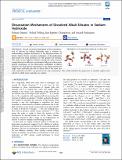Dissociation Mechanisms of Dissolved Alkali Silicates in Sodium Hydroxide
Author(s)
Dupuis, Romain; Pellenq, Roland Jm; Champenois, Jean-Baptiste; Poulesquen, Arnaud
DownloadPublished version (2.835Mb)
Publisher with Creative Commons License
Publisher with Creative Commons License
Creative Commons Attribution
Terms of use
Metadata
Show full item recordAbstract
Recent accelerated simulations of the decondensation of silicates by sodium hydroxide open a window on understanding complex mechanisms of the depolymerization of silicate chains. Herein, complex mechanisms of decondensation that involve two water molecules (or OH- groups) are unveiled. The study of two different solutions, having the same chemical composition but in different concentration, help one to draw more general conclusions on the dissociation mechanism in silicate solutions. We find that the dissociation is not always assisted by single water molecules but that in about 20% of the cases two water molecules (or OH-) are present in the near environment. The results underline the importance to consider explicit water solvent in which water molecules are reactive.
Date issued
2020-03Department
MIT Energy Initiative; Massachusetts Institute of Technology. Department of Civil and Environmental EngineeringJournal
Journal of Physical Chemistry C
Publisher
American Chemical Society (ACS)
Citation
Dupuis, Romain et al. "Dissociation Mechanisms of Dissolved Alkali Silicates in Sodium Hydroxide." Journal of Physical Chemistry C 124, 15 (March 2020): 8288–8294 © 2020 American Chemical Society
Version: Final published version
ISSN
1932-7447
1932-7455